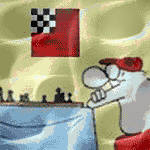Diamant
Admin


Messages : 5050
Points : 11904
Date d'inscription : 13/04/2013
Localisation : Devant mes... échiquiers électroniques ?! ♔♕♖♗♘♙ ..ლ(▀̿̿Ĺ̯̿̿▀̿ლ)..
![[Eugène Znosko-Borovsky] HOW TO PLAY CHESS ENDINGS Empty](https://2img.net/i/fa/empty.gif) |  Sujet: [Eugène Znosko-Borovsky] HOW TO PLAY CHESS ENDINGS Sujet: [Eugène Znosko-Borovsky] HOW TO PLAY CHESS ENDINGS ![[Eugène Znosko-Borovsky] HOW TO PLAY CHESS ENDINGS Empty](https://2img.net/i/empty.gif) Lun 16 Nov 2020 - 22:39 Lun 16 Nov 2020 - 22:39 | |
| ![[Eugène Znosko-Borovsky] HOW TO PLAY CHESS ENDINGS Eugzon10](https://i.servimg.com/u/f16/18/23/33/47/eugzon10.jpg) Eugène Alexandrovitch Znosko-Borovsky né le 16 août 1884, à Pavlovsk, Saint-Pétersbourg, en Russie Eugène Alexandrovitch Znosko-Borovsky né le 16 août 1884, à Pavlovsk, Saint-Pétersbourg, en Russie
décédé le 31 décembre 1954, à Paris était un maître d'échecs français d'origine russe mais aussi un professeur,
un auteur, un critique musical et théâtral.
Né à Saint-Pétersbourg, il s'installa à Paris en 1920 et y vécut toute sa vie. Vainqueur du tournoi de Paris 1930.
Champion de Paris 1931. Il est l'auteur en autre de "Comment il ne faut pas jouer aux échécs". (Paris 1930)https://fr.wikipedia.org/wiki/Eug%C3%A8ne_Znosko-BorovskyHOW TO PLAY CHESS ENDINGS 1974 Eugène Znosko-Borovsky ( 182.pages) How many chess players really know what to do in the end game?
More is demanded in this stage of the game than in any other, and the knowledge and imagination that saw you through the opening and middle game are just not enough to carry you through the end game also.
You need a thorough knowledge of the principles of chess endings, and this book is an excellent introduction to those principles.
World-famous chess teacher Eugene Znosko-Borovsky clearly explains the importance of tempo, the rule of the triangle, the idea of related squares, the power of the pawn and king, and the versatility of the rook.
Each piece is studied individually, and many common end game situations are considered.
Drawing on games from such master players as Morphy, Marshall, Steinitz, Capablanca, Alekhine, Lasker, and Botvinnik, Znosko-Borovsky shows you how to think during the end game no matter what pieces you may have or what situation you may be in.
Special consideration is given to the theory of positional play, the conception and execution of a plan, and the recognition of tactical opportunities.
Emphasis throughout the book is on understanding principles, rather than memorizing moves, with the result that the reader will be able to apply Znosko-Borovsky’s techniques to almost any situation that may arise.
The author’s well-known clarity of exposition makes this book most useful to a beginner or intermediate player.![[Eugène Znosko-Borovsky] HOW TO PLAY CHESS ENDINGS How_to13](https://i.servimg.com/u/f16/18/23/33/47/how_to13.jpg)  Source de ce chess book ! Source de ce chess book ! |
|

![[Eugène Znosko-Borovsky] HOW TO PLAY CHESS ENDINGS Empty](https://2img.net/i/empty.gif) Aujourd'hui à 0:09 par
Aujourd'hui à 0:09 par 




![[Eugène Znosko-Borovsky] HOW TO PLAY CHESS ENDINGS Empty](https://2img.net/i/fa/empty.gif)
![[Eugène Znosko-Borovsky] HOW TO PLAY CHESS ENDINGS Eugzon10](https://i.servimg.com/u/f16/18/23/33/47/eugzon10.jpg)
![[Eugène Znosko-Borovsky] HOW TO PLAY CHESS ENDINGS How_to13](https://i.servimg.com/u/f16/18/23/33/47/how_to13.jpg)
![[Eugène Znosko-Borovsky] HOW TO PLAY CHESS ENDINGS Perso-7](https://2img.net/h/www.smileys-gratuits.com/smiley-personnage/perso-7.gif) ~
~ ![[Eugène Znosko-Borovsky] HOW TO PLAY CHESS ENDINGS Sms_1110](https://i.servimg.com/u/f16/18/23/33/47/sms_1110.jpg)